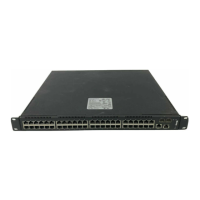Layer 2,3,IPv6+QoS Switch
_____________________________________________________________________________
Layer 2,3,IPv6+QoS Network Switch User Manual Version 0.1 Page: 625/970
11 Web-Based Management Interface
11.1 Overview
Your Layer 3 Network Switch provides a built-in browser software interface that lets you
configure and manage it remotely using a standard Web browser such as Microsoft Internet
Explorer or Netscape Navigator. This software interface also allows for system monitoring and
management of the Network Switch. When you configure this Network Switch for the first time
from the console, you have to assign an IP address and subnet mask to the Network Switch.
Thereafter, you can access the Network Switch’s Web software interface directly using your
Web browser by entering the switch’s IP address into the address bar. In this way, you can use
your Web browser to manage the Switch from any remote PC station, just as if you were
directly connected to the Network Switch’s console port.
The 7 menu options available are: System, Switching, Routing, Security, IPv6, QOS, and IP
Multicast.
1. System Menu: This section provides information for configuring switch interface (port),
SNMP and trap manager, Ping, DHCP client, SNTP, system time, defining system
parameters including telnet session and console baud rate, etc, downloading switch
module software, and resetting the switch module, switch statistics and Layer 2 Mac
address.
2. Switching Menu: This section provides users to configure switch Port-Based VLAN,
Protocol-Based VLAN, Voice VLAN, Guest VLAN, GARP, IGMP Snooping, Port Channel,
Spanning Tree, and 802.1p priority Mapping, port security, LLDP, and VTP.
3. Routing Menu: This section provides users to configure OSPF, RIP, Router Discovery,
Static Route, VLAN Routing, VRRP, BOOTP/DHCP relay, DNS relay, Tunnels and
Loopbacks.
4. Security Menu: This section provides users to configure switch securities including
802.1x, Radius, TACACS+, IP filter, Secure Http, and Secure Shell.
5. IPv6 Menu: This section provides users to configure OSPFv3, RIPng, DHCPv6, IPv6
Static Route, and IPv6 Routing Interface.
6. QOS Menu: This section provides users to configure Access Control Lists, Differentiated
Service, and Class of Service.
7. IP Multicast Menu: This section provides users to configure DVMRP, IGMP Snooping,
IGMP Snooping Querier, MLD Snooping, MLD Snooping Querier, Multicast, PIM-DM,
PIM-SM. It also provides information for a multicast distribution tree.
8. Cluster: This section provides users to configure network cluster management.

